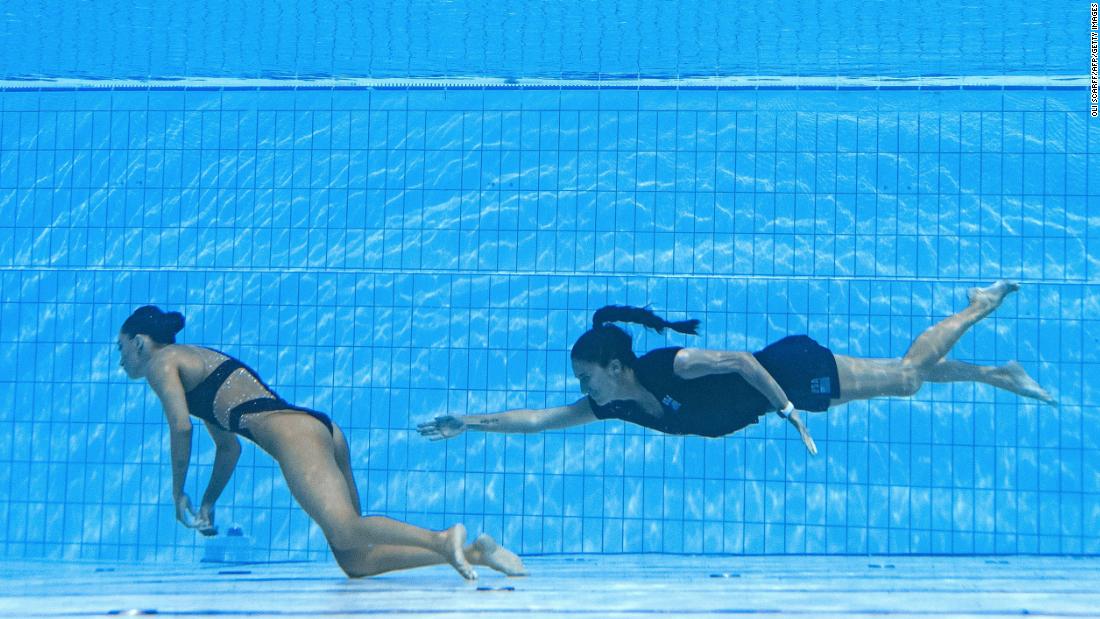
Anita Alvarez is unconscious at the bottom of the pool after the end of her routine at the FINA World Aquatic Championships. Her knees are touching the tiles, her arms are limp, her eyes are closed. Later, we learn she wasn’t breathing.
What would have happened had her coach, Andrea Fuentes, not noticed the swimmer’s feet seemed more pale than normal, putting her on high alert, and what if she had not reacted like lightning by jumping in to save her athlete when she saw the American was sinking instead of rising to breathe?
Perhaps for those who never watch artistic swimming, or only do so every four years at the Olympics, the most astonishing thing of all is hearing those involved in the sport talk about how what happened to Alvarez in Budapest is a risk that comes with the sport.
Indeed, that was the second time Fuentes had rescued Alvarez. Last year, she leapt into the pool during an Olympic qualification event to pull the 25-year-old to safety.
Fuentes told CNN this week that swimmers regularly hold their breath for extended periods to improve their lung capacity, but said those practices never went against medical advice.
Former Spain artistic swimmer Gemma Mengual, a three-time Olympian, described feeling a tingling sensation in her face, of almost passing out in the pool and ditching a routine for fear of what could happen.
“It’s a very demanding sport. You always went to the limit. I always went out there scared when I competed,” she told Spain’s Atresmedia.
And that, in essence, is what elite sport is about. It is about pushing yourself to the limit, physically and mentally; in training, in competition, day-after-day, year-after-year, because that is where the bar has been set, in every sport.
Synchronized swimmers may look serene, balletically dancing in water. They are poised, they smile, they charm the crowds. Heck, there’s even music, make up and sequins.
It all looks effortless, but that is because those who excel always make it look so. It doesn’t mean there is no pain before, during or after.
“I’ve been an athlete all my life — for 20 years in the pool … sometimes, there’s little prices that it’s OK to pay,” Fuentes told CNN.
“And in all the sports, if you know any athletes of high performance, that’s part of the beauty — pushing through your limits and grow from it.”
In sport, there is no greatness without sacrifice. There is no being very, very good without sacrifice. Elite athletes are the best in their trade, and while they cannot all be the greatest of all time, they are all still the best in the world at what they do, and to be that good you must possess certain characteristics. Talent, yes, single-mindedness, certainly, but also the ability to push yourself, to live life to the extreme — and that is hard.
They miss parties, decline nights out, ruin family holidays, all for what British Cycling during its golden heyday of the last decade would describe as “marginal gains.”
That is small improvements, refining everything by 1%, to significantly increase your overall performance; because when the difference between success and failure is a fraction of a second or an inch, every little thing matters.
For British Cycling, that meant hiring a surgeon to teach each rider the best way to wash their hands to reduce the chances of catching a cold and choosing the best type of pillow and mattress so each rider could have the best night’s sleep.
When constantly doing that little bit extra is your life, then pushing yourself to such an extreme — or more pertinently, not knowing where the limit actually is — during competition so that your wellbeing, or even your life, is put in danger, perhaps becomes more comprehensible to the layperson.
In a 2012 column in England’s The Guardian, triathlete Lesley Paterson wrote: “Every top athlete is a little crazy, a little obsessive, a lot selfish and certainly not quite the norm.”
That is perhaps why athletes need to be safeguard, to be looked after by those who realize winning should not come at any cost.
“We all have seen images where some athletes don’t make it to the finish line and others help them to get there,” she said.
At the Gold Coast Commonwealth Games, Scotland’s Callum Hawkins missed out on men’s marathon gold after collapsing and hitting his head on a roadside barrier, two kilometers from the end in the scorching east coast heat.
There is also, of course, the tale of the now mythologized Greek runner Pheidippides, the inspiration for the modern marathon. Did he announce Greece’s victory over the Persians and fatally collapse after running from Marathon to Athens? It depends whom you ask.
But elite athletes tend to differentiate between risk and consequence. For Alex Honnold, widely regarded as the greatest rock climber of all time, the risk of climbing vertiginous rocks without rope is low, the consequence, which could be death, of course, is high.
In 2017, the American became the first person to climb the 3,200-ft monolith El Capitan without any ropes, a skill known as free soloing. Attempting the feat was, he told CNN a few years ago, “business as usual” and built on decades of practice.
And it is that practice, the thousands of hours put in to perfect a craft, that the ordinary person doesn’t see. The end-product is usually a faultless performance, enhancing the athlete’s status as an otherworldly being, which is why a dramatic fall or rescue becomes headline news around the world.
What happened in Budapest this week was a reminder that elite athletes, though they are far from average, are human too.
